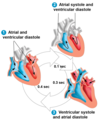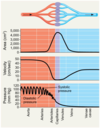Circulation Flashcards
(96 cards)
What are the basic roles of the circulatory system?
- Transporting oxygen and nutrients throughout body to tissues 2. Transport carbon dioxide and other waste to the respiratory system, digestive system, and the urinary system
What are the roles of the respiratory system?
- Take up oxygen 2. Release CO2
Must every organism exchange materials with its environment?
YES
What is the difference in how unicellular and multicellular organisms exchange materials with their environment?
Unicellular - Exchanges occur directly with environment Multicellular - Exchange directly with environment is not possible due to diffusion of gases longer than a few millimeters is much too slow.
Since multicellular organisms cant exchange material directly with their environment due to the slow process of long distance diffusion, what are the two solutions resulted from natural selection?
- Body size and shape that keeps cells in direct contact with environment: Cnidarians (jellyfish) and flatworms that have gastrovascular cavities.
- In most animals, transport systems connect organs of exchange with the body cells, this is mainly an internal transport system that circulates fluid.
What is the function of a gastrovascular cavity?
These function in digestion, circulation, and respiration.
Present in organisms with body shapes that allow for many of their cells to be in close contact with their environment.
Rather than having a simple gastrovascular cavity, more complex organisms need a circulatory system to trnasport and exchange nutrients, what are the two different types of circulatory systems these more complex organisms may have?
Open circulatory system
Closed circulatory system
What are the three basic components of a circulatory system?
- Fluid (blood or hemolymph)
- Tubes (vessels)
- Pump (heart)
What animals tend to have an open circulatory system?
Arthropods (grasshoppers, lobsters, crabs) and some Mulloscs (snails, slugs, clams, NOT SQUIDS OR OCTOPUS)
What is the circulatory fluid of an open-circulatory system calle? How does it differ from an open-circulatory systems fluid?
Hemolymph
This fluid is emptied into body cavities and bathes the organs directly which allows for exchange of nutrients between body cells. This fluid also acts as the interstitial fluid of the body.
As the heart relaxes the hemolymph is drawn back to the heart through pores.

What are some advantages of a open circulatory system that is described in class?
Not as much energy is required for these systems to function, likely due to lower hydrostatic pressures
Spiders use the hydrostatic pressure of the open circulatory system to extend their legs.
What animals tend to have a closed circulatory system?
Earthworms and Vertebrates

What is the fluid found in a closed circulatory system called? How does it differ from hemolymph?
Blood
Blood is confined to vessels and is different from the interstitial fluid. Exchange occurs between the blood and interstitial fluid, then again between the interstitial fluid and the body cells.
What are some advantages of a closed circulatory system?
Higher pressure of blood allows for better O2 and nutrient exchange in larger more active animals
Better regulation of distribution of blood to different organs.
In a vertebrate, what is another name for their circulatory system?
Cardiovascular system
Cardio = heart and vascular = vessels
What are the 6 different types of blood vessels described in class and a basic description of each?
Arteries - larger vessels that carry blood away form heart to organs
Arterioles - smaller vessels in comparison to arteries, carry blood to capillaries
Capillaries - microscopic vessels that are sites of gas and chemical exchange
Capillary Beds - networks of capillaries between blood and interstitial fluid
Venules - receive blood from capillaries
Veins - larger vessels that receive blood from venules, carry blood to the heart
What is the distinguishing factor between arteries and veins?
The direction they carry blood
NOT O2 CONTENT
What are the different chambers of the heart and a description of each?
Atria (singular: atrium) - Chamber that receives blood that is entering the heart.
Ventricles (singular: ventricle) - chambers that pump blood out of the heart.
Do the number of chambers in the heart as well as their degree of separation differ among vertebrates?
YES
What is single circulation? What vertebrates have this type of closed circulatory system? How many capillary beds does blood travel through before returning to the heart? How many chambers does the heart have? What is the oxygen content of the blood in the heart?
There is a single circuit that travels from the ventricle of the heart to not only to the gill capillary bed for gas exchange, but then to the body capillaries to distribute the O2 and nutrients before returning the the atrium of the heart. Meaning that the blood travels through two capillary beds before returning to the heart.
Heart consists of two chambers.
Bony fishes, sharks, rays
O2 content of blood in the heart is always poor

What is a closed circulatory system with double circulation? What vertebrates have this system? Describe the right side of heart and the left side of the heart in double circulation. How many pumps (hearts) do these types of circulations have?
There are two circuits of blood flow present.
Amphibians, reptiles, and mammals
One single pump (heart) used for both circuits
Right side: delivers O2 poor blood to the beds of gas exchange tissues (pulmonary circuit in mammals and reptiles)
Left side: pumps O2 rich blood that has returned from the pulmonary circuit to organs and tissues throughout the body. Also called the systemic circuit.
Describe the double circulation of an amphibian. How does it differ from a mammalian double circulation?
- Amphibians have a 3 chambered heart (2 atria and 1 large venticle)
- Some mixing of O2 rish and O2 poor blood may occur (about 10% of each), but 90% of O2 rich and O2 poor blood remains divided by a ridge in the ventricle that directs each to their respective circuit.
- O2 poor goes to a pulmocutaneous circuit, O2 rich goes to systemic circuit.
- When in water, they can shunt circulation from the ineffective lungs and favor their cutaneous circulation.

How does the double circulation of turtles, snakes, and lizards differ from mammalian double circulation?
They also have a 3 chambered heart, but differ from amphibians in that they have an incomplete septum that partially divides the ventricle.
Describe the mammalian and bird double circulation. How many chambers? Complete septum? How does the 4-chambered heart of the mammal differ from the 4-chambered heart of crocodilians and why?
4 chambered heart:
Right side: receives O2 poor blood from body and pumps it to lungs
Left side: Receives O2 rich blood from lungs and pumps it to body.
Complete septum divides venticles.
Crocodilians also have 4 chambered heart, but pulmonary and systemic circuits are connected where the arteries exit the heart. This allows for blood to be shunted from pulmonary circuit when underwater and not using lungs.













